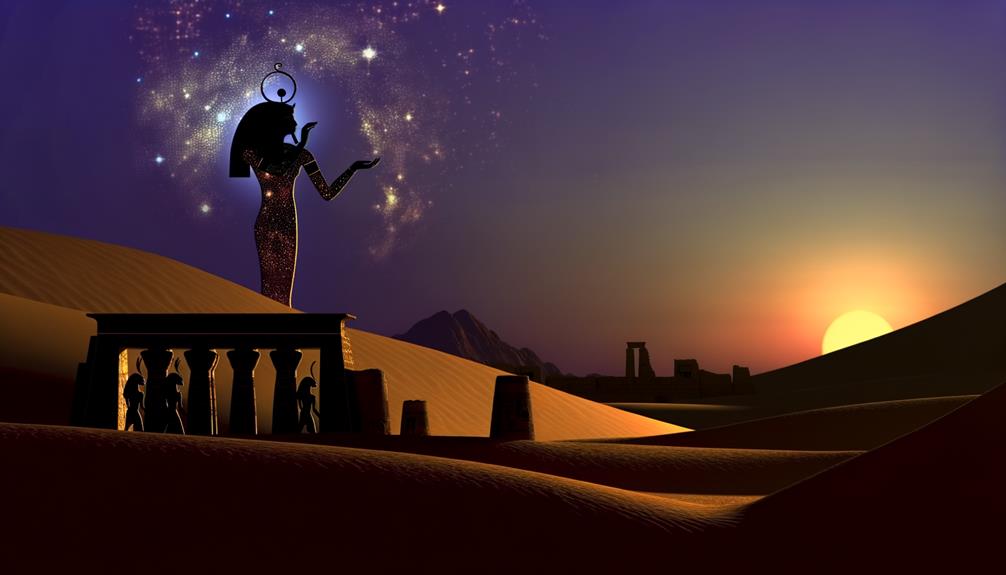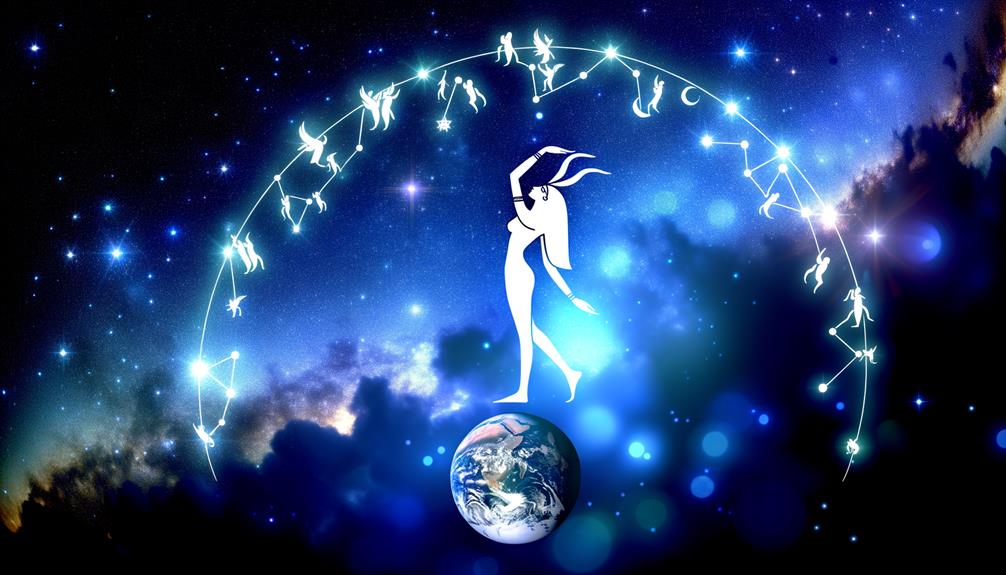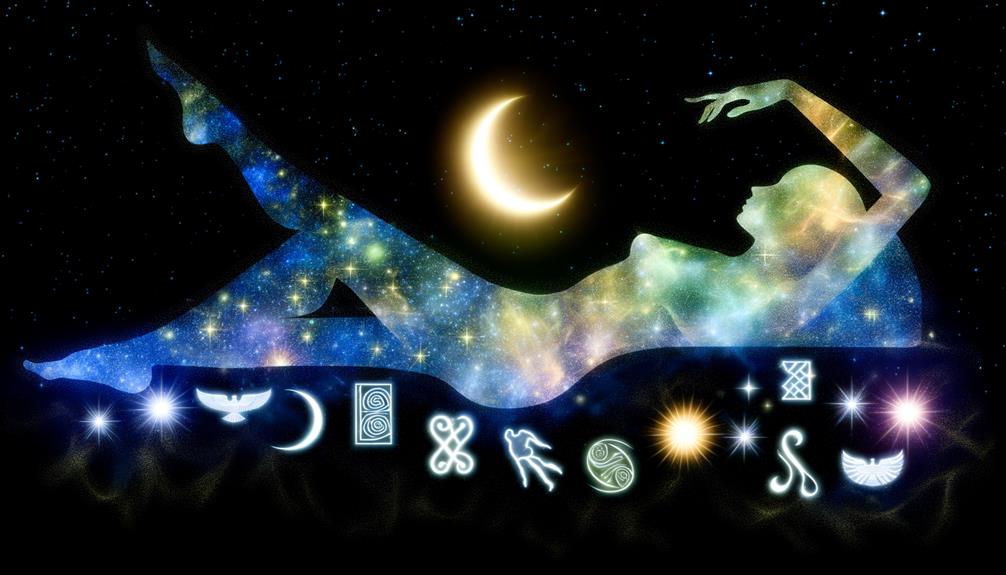Let’s think back to a recent trip I made to the old city of Heliopolis. I was blown away by the sheer number of carvings and images of the goddess Nut. Now, she’s a pretty fascinating character in Egyptian mythology. Imagine her as the physical embodiment of the sky. Her tale is all about cosmic romance, heavenly conflicts, and second-to-none protection. Typically, she’s shown as a woman bending over the earth, keeping it safe from the chaotic forces out there in the universe. But there’s more to it than just her physical depiction. Nut’s complex tale is interwoven with other gods and goddesses, stories of how the world was created, and even the journey of the dead. It’s no wonder people are so interested in her. So, let’s break it down. Why does Nut matter so much in ancient Egyptian mythology? What are the various parts of her tale and how have they impacted the customs and beliefs of ancient Egypt?
The Origin of Nut

Let’s delve into the world of ancient Egyptian myths, where Nut, the goddess of the sky, has a fascinating backstory. Nut is a celestial entity of major importance in the ancient Egyptian pantheon. She’s usually portrayed as a woman stretching over the earth, demonstrating her role as the sky goddess.
Now, let’s talk about Nut’s family tree because it’s quite interesting. Her parents are Shu and Tefnut, which makes her a direct product of the first act of creation. But her story doesn’t stop at her birth. It extends to her relationship with her brother Geb, and the five children they had together. This part of the story highlights the dynamic relationship between Nut and Geb, the earth god, setting up a key dichotomy present in many Egyptian myths.
As the sky goddess, Nut had to outsmart Khonsu, the moon god, to get five extra days for her children’s birth. This story adds another layer to our understanding of Nut, showcasing her cleverness and determination. The story of Nut’s origin is a major piece of the puzzle when trying to comprehend Egyptian mythology.
Nut’s Cosmic Love Story

Diving deep into Nut’s celestial love saga, we stumble upon a fascinating narrative of forbidden love with her sibling Geb, a bold defiance of a sacred command, and the birth of their offspring, which strengthens her prominence in Egyptian mythology. Nut, usually represented as a woman stretching over the earth, was the offspring of Shu, the deity of air, and Tefnut, the deity of moisture. This makes her a divine figure of the sky and heavens.
Nut’s secret relationship with Geb, the Egyptian deity of earth, was a bold defiance to Ra, the sun god’s command. Their unity gave birth to important Egyptian gods – Osiris, Isis, Seth, and Nephthys – highlighting their key role in the creation narrative. The birth of their children symbolised a peaceful balance between the sky (Nut) and the earth (Geb), a concept that is a cornerstone of Egyptian mythology.
Despite Ra’s efforts to pull Nut and Geb apart, their fiery love narrative remains as a testament to Nut’s impact and power. Her character, often portrayed as nurturing and protective, is a central figure in the Egyptian pantheon. As the sky goddess, Nut’s love story in the stars continues to fascinate us and deepens our comprehension of ancient Egyptian mythology.
Nut as Protector of The Deceased

The goddess Nut, with her celestial love story, has more to her than just that. She plays a significant part in the afterlife, being a constant guardian for those who have passed away. You often see Nut depicted on the inside cover of sarcophagi, highlighting her duty of protection. This is emphasized by the commonly used Egyptian plea, ‘O my Mother Nut, Nut shall not let harm come to you’.
In the tales of Egyptian mythology, Nut is portrayed as a nude woman covered in stars, bending over the earth god, Geb, who is also her brother and lover. This image of Geb and Nut together represents Nut’s protective nature over both the living and the deceased. It was a common belief among Egyptians that those who died would join Nut among the stars that never fade, remaining safe and sound under her vigilant care.
Nut’s caring personality and her duty as the guardian of the dead made her crucial in funeral rituals. It was often said that the dead were ‘put among the indestructible’, a clear nod to Nut’s star-filled domain. As such, Nut’s protective duty brings a sense of peace, offering reassurance of a safe journey in the afterlife.
The Symbolism of Nut
Let’s take a closer look at the symbolism of Nut, a fascinating character from ancient Egyptian mythology. Nut is often portrayed as a woman arched over the earth, symbolizing the sky and celestial bodies. But her divine importance isn’t just limited to the heavens. She’s also seen as a goddess of birth, being the mother to five notable children, including major Egyptian figures like Osiris and Isis.
There’s certainly a lot to Nut’s symbolism. Let’s break down three of the most interesting facets:
- Nut is seen as a guardian figure. Her body, adorned with stars, forms a protective barrier over the Earth. This offers a sense of safety and security, shielding us from the disorderly vastness of the universe.
- Nut is also recognized as the mother of the sun god. This associates her with the cycle of day and night. The concept is that she consumes the sun each night, only to give birth to it each morning. This is a powerful representation of renewal and continuity.
- Lastly, Nut is often compared to Shu, the Egyptian god of the air. This connection symbolizes balance and interdependence in nature.
Through these elements, we can appreciate how Nut’s symbolism is rich and layered. It’s not just about her role as a celestial figure, but also her representation of protection, renewal, balance, and nature’s interconnectedness.
Worship and Influence of Nut

Let’s dive into the story of Nut, a fascinating celestial goddess, and explore the depth of her impact on ancient Egyptian culture. Nut, recognized as the sky goddess, received messages of admiration and respect, signifying her substantial power and influence. Her footprint was particularly prominent in the 71st nome of ancient Egypt, a place where her worship was notably intensified.
Often, Nut was portrayed as a woman arching over the earth, a depiction of her protective role. This stance also symbolized her connection with the earth god Geb, as she was frequently depicted lying atop him. The union of Nut and Geb resulted in five offspring, including the notable Horus the Elder. According to mythology, Nut also gave birth to the sun god, Ra every morning, which demonstrated her crucial role in the daily life of Egyptians.
Nut’s worship provides a window into a culture deeply connected with the cosmos and natural cycles. Each facet of her adoration emphasizes the understanding of the cosmos’ influence on life on earth. Indeed, Nut was more than a deity to the Egyptians; she symbolized life’s cyclical nature and their profound bond with the universe.
Frequently Asked Questions
What Is the Myth of the Nut Goddess?
Let’s chat about this intriguing Egyptian myth, where I take on the persona of Nut, the goddess of the sky. You’ll often see me painted or carved as a figure spanning the earth, a symbol of safeguarding. The tales spun around me involve creation, the sun, the moon, and even the passage of the dead.
Who Are the Children of the Nut Goddess?
Do you know about the children of Nut, the Sky Goddess from Egyptian mythology? Nut had five children with her brother, Geb. They were Osiris, Isis, Seth, Nephthys, and Horus. These gods and goddesses aren’t just random names, they all hold a unique place in the tales and legends that make up Egyptian mythology. Pretty interesting, isn’t it?
What Is the Spiritual Meaning of the Goddess Nut?
So, let’s chat about Nut, the sky goddess from ancient Egypt. She’s more than just a figure from mythology. Think of her as a symbol for the vast and unknowable universe, acting as a guardian force. She also represents the cosmic cycle of life and death, suggesting a never-ending process of renewal. It’s a pretty fascinating concept, don’t you think?
What Is the Story of Nut and Geb?
Let’s talk about the fascinating story of Nut and Geb, shall we? These two are major characters from ancient mythology, embodying the sky and the earth. You’ll often see them depicted as being entwined, but here’s the twist – their father, Shu, decided to pull them apart. Isn’t that something? This story isn’t just for entertainment though. It’s actually a metaphor for how the world came into being, at least according to the vivid imagination of ancient Egyptians. Quite the tale, eh?

